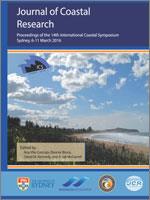Héquette, A. and Cartier, A., 2016. Theoretical and observed breaking wave height on a barred macrotidal beach: Implications for the estimation of breaker index on beaches with large tidal range. In: Vila-Concejo, A.; Bruce, E.; Kennedy, D.M., and McCarroll, R.J. (eds.), Proceedings of the 14th International Coastal Symposium (Sydney, Australia). Journal of Coastal Research, Special Issue, No. 75, pp. 861–866. Coconut Creek (Florida), ISSN 0749-0208.
Although a large number of studies were dedicated to the observation and prediction of wave height at breaking, field investigations were essentially carried out in micro- to mesotidal environments. Here we report the results of a study conducted on a barred macrotidal beach of northern France during which video observations of wave breaking were carried out simultaneously with measurements of wave data using a series of hydrodynamic instruments deployed across the intertidal and the nearshore zones and an offshore wave buoy. Our results show that waves were breaking when the ratio of wave height to depth (Hb/hb) was comprised between approximately 0.2 to 0.45, the lower value being slightly lower than what is commonly reported in the literature for macrotidal beaches. Comparison of measured and calculated wave height at breaking using a series of predictive equations revealed that the Rattanapitikon et al. (2003) formula gave the best results for our data set. Predicted breaker heights were nevertheless overestimated when using offshore wave measurements and better results were obtained with wave data recorded in 5 m water depth instead. This can be explained by the presence of offshore tidal sand banks that are responsible for significant wave refraction and wave energy dissipation. These results contribute to determine more precisely the range of appropriate breaker index values for barred macrotidal beaches and highlight that nearshore wave parameters should be used rather than offshore wave statistics for predicting breaking wave height and breaking depth where sand banks strongly alter wave characteristics.





